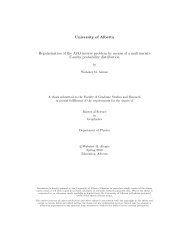Soner Bekleric Title of Thesis: Nonlinear Prediction via Volterra Ser
Soner Bekleric Title of Thesis: Nonlinear Prediction via Volterra Ser
Soner Bekleric Title of Thesis: Nonlinear Prediction via Volterra Ser
Create successful ePaper yourself
Turn your PDF publications into a flip-book with our unique Google optimized e-Paper software.
5.3. SYNTHETIC DATA EXAMPLES 78<br />
Notice that the new operator corresponds to the filter that predicts the noise or<br />
error and not to the signal (equation (3.14)). In addition, equation (6.1) is valid<br />
for both linear prediction and nonlinear prediction. The operator f is then applied<br />
to the data (primaries plus multiples). The concept is illustrated with examples.<br />
5.3 Synthetic Data Examples<br />
Figure 5.2(a) represents three linear events with one primary (horizontal event) and<br />
two multiples (dipping events). The data are similar to the examples provided in<br />
Abma et al. (2005). Figure 5.2(b) is an estimation <strong>of</strong> the multiples and Figure 5.2(c)<br />
is the primary estimation <strong>via</strong> the f − x linear prediction filter (Spitz, 1999). The<br />
removal <strong>of</strong> multiples and the preservation <strong>of</strong> the primary reflection is fairly good.<br />
In Figure 5.3(a) I portray one primary (horizontal event) and two multiples<br />
that cannot be approximated by linear events. Figure 5.3(b) shows the distorted<br />
estimation <strong>of</strong> multiples. Figures 5.3(c) and 5.3(d) are the solution <strong>via</strong> the classical<br />
linear prediction and the solution with the third- order <strong>Volterra</strong> series, respectively.<br />
Linear prediction algorithm can not removed any multiples, the nonlinear prediction<br />
error filter, on the other hand, was able to model the curved multiples and attenuate<br />
multiples. Both methods were able to preserve the primary event without affecting<br />
its amplitude response.<br />
In Figure 5.4(a) I portray a similar synthetic data example with one primary and<br />
two multiples. Figure 5.4(d) shows the distorted estimation <strong>of</strong> multiples. Figures<br />
5.4(b) and 5.4(c) are the solution <strong>via</strong> classical linear prediction and the solution<br />
with the third- order <strong>Volterra</strong> series, respectively. <strong>Nonlinear</strong> prediction error filter<br />
subtracts more multiples than linear one. In this example, I illustrate the removed









